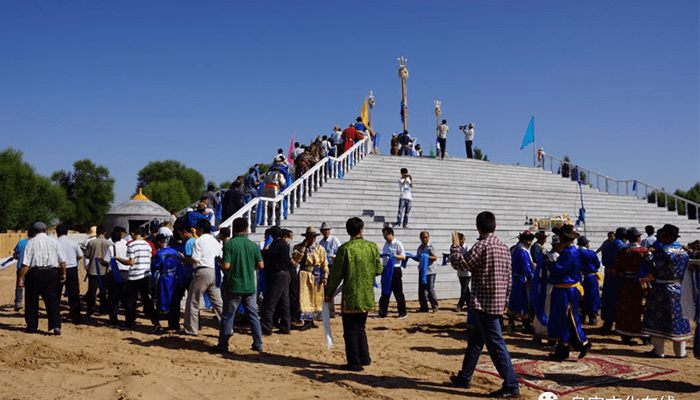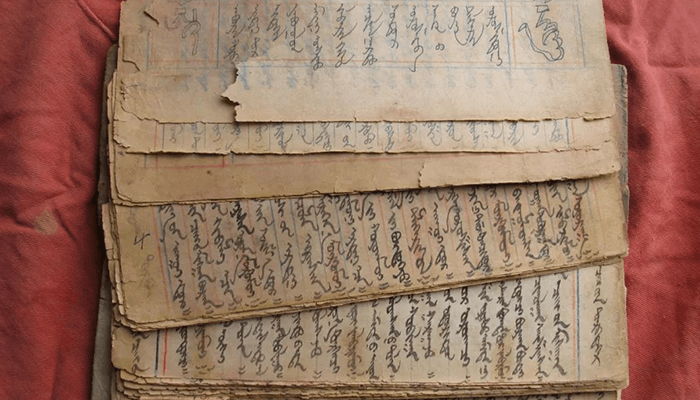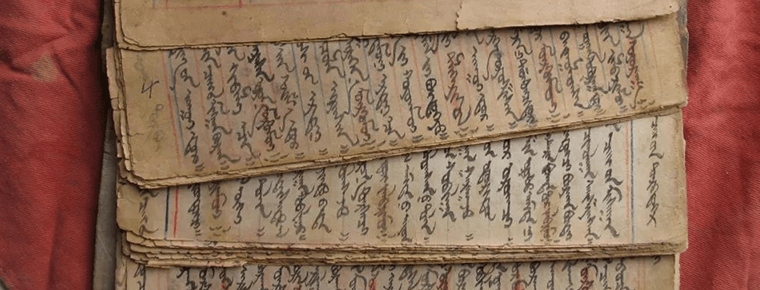Chagan Sulide Festival
Chagan Sulide Festival
Sulide, in Mongolian, has the meaning of auspiciousness, loftiness, harmony, unity and harmony. The sacrifice of Chagan Sulide is the natural worship of the universe of heaven and earth gradually formed by the Mongolian people in a long period of time.
The Ushen Banner of Ordos City, Inner Mongolia Autonomous Region, is the most complete preservation and inheritance of Chagan Sulide sacrifice. The Mongolian herdsmen living here mostly stand in front of the door of the Sulide-shaped "Heymory", and every morning herdsmen burn incense and pray in front of "Heymory", which is the concentrated embodiment of Chagan Sulide culture in this area. Chagan Sulide's sacrifices mainly include celestial sacrifices, star sacrifices, fire sacrifices, day sacrifices, month sacrifices, seasonal sacrifices, New Year's sacrifices, majestic sacrifices and so on.
The sacrifice of Chagan Sulide was handed down from generation to generation by the Dalhut tribe, the watchman of Genghis Khan. The grand ceremony formed in the 13th century has been completely preserved to this day, and has been enriched and perfected with the development of the times. The origin of Chagan Sulide is recorded in Secret History of Mongolia and Benji of Yin Taizu of Yuan Dynasty. It is said that in 1206, Tiemuzhen, who had gone through difficulties and finally unified the grassland, was respected as Genghis Khan. After the establishment of the Great Mongolia, Chagan Sulide was set up as a symbol of the country outside the Golden Curtain. Mongolians still believe that white represents purity, supremacy and nobility. Chagan Sulide is composed of a master Sulide and eight accompanying Sulide. Therefore, it is called Jiuzhagan Sulide, or "Jiuzhao Baiyi" (also known as "Jiuzhao Baiqi"). The Chagan Sulide Altar is composed of three parts: the main flag, the Zongqi and the substitute flag. The top of the main flag is made of hill-shaped gold-plated cylindrical iron. It is one foot three inches tall and reeled with nine-figure white mane. The flagpole is thirteen feet tall, three inches in diameter, and its body is white. The base of the main flag is tortoise-shaped stone. So far, the sacrifice of Chagan Sulide has been handed down for more than 800 years. In 2006, Genghis Khan was selected as the first national intangible cultural heritage list. In 2014, Chagan Sulide sacrifice was listed in the fourth batch of National Intangible Cultural Heritage Representative projects.
The original text of Chagan Sulide's Words of Sacrifice
As a manifestation of national self-esteem and spiritual strength, Sulide culture is like a clear spring that merges into the long river of Chinese national culture and is a brilliant treasure in the treasure house of national culture. The Mongolian traditional culture of "Sulide" which is a pluralistic aggregation is a rich cultural resource and tremendous cultural wealth of the Ushen people. Sulide culture not only embodies the complete inheritance of Mongolian traditional culture, but also deduces a heavy history, which has important historical significance and practical significance of keeping pace with the times.
For thousands of years, Sulide has long protected the excellent Mongolian herdsmen.






-
1.Old Beijing fried Morchella
The most famous famous food in Beijing is old Beijing tripe and Beijing roast duck. As for the oldest and most prosperous snacks in Beijing, belly burst is definitely the best among them.
Time 2018-10-27 -
2.Cheng Yang eight Zhai
Chengyang Bazhai is located in Sanjiang Dong Autonomous County, Liuzhou City, Guangxi, 19 kilometers away from Sanjiang County. There are eight natural villages in Chengyang Bazhai, commonly known as
Time 2019-01-05 -
3.Hometown of Huang Di
The scenic spot of Huangdi's hometown is located in Xuanyuan Road, Xinzheng City, Zhengzhou City, Henan Province. It is the residence of Xiong clan recorded in the history
Time 2019-01-18 -
4.Qingxiushan Mountain
Qingxiushan Scenic Area is a national AAAAA scenic spot in Nanning. Qingxiu Mountain is a key scenic spot in Nanning. In addition to protecting and restoring the original historic sites
Time 2019-02-07 -
5.Eight treasures bean curd
Babao bean skin is a delicacy. Main raw materials: bean curd 6 white sesame 25 grams pig meat 120 grams of letinous edodes.
Time 2019-03-25 -
6.Automative lighting
Car lights are also known as "teasing Momei" and "running a dry boat". It is mainly performed around the Spring Festival.
Time 2019-04-16 -
7.Production Techniques of Chinese Painting Pigments
Jiang Sixutang's skill in making Chinese painting pigments is one of the intangible cultural heritages. The manufactured products of Jiang Sixutang Chinese Painting
Time 2019-05-02 -
8.Kazakh Tiermai
Tiermai, which means "short poem" in Kazakh language, usually implies philosophy in the poem in a narrative way to give people inspiration. This kind of poem is widely spread among Kazakh he
Time 2019-05-02 -
9.Flower Huaer
"Huaer" is a folk song created and shared by Han, Hui, Tibetan, Dongxiang, Baoan, Sarah, Tu, Yugu and Mongolian nationalities in Gansu, Qinghai and Ningxia provinces in Northwest China.
Time 2019-05-04 -
10.Taoist Music of Xuanmiaoguan in Suzhou
The Taoist music of Suzhou, represented by the Taoist music of Xuanmiaoguan, belongs to the Zhengyi Taoist music, and is an integral art with the performing process of Zhai Yin Fa. It sings different
Time 2019-06-17 -
11.Yingge Liushu
Yingge Liushu, also known as Yingge Liuzi, is a traditional art form of rap and singing spread in southwestern Shandong, southern Shandong, Eastern Henan and Northern Jiangsu. Legend has it that the L
Time 2019-07-14 -
12.Administrative division of Nanchong
Nanchong City governs nine county-level administrative divisions (Municipal District 3, county-level city 1, county-level 5), and 241 township level administrative divisions (street 42, town 161, township 38). It covers an area of 12514 square kilometers and has a population
Time 2020-12-17